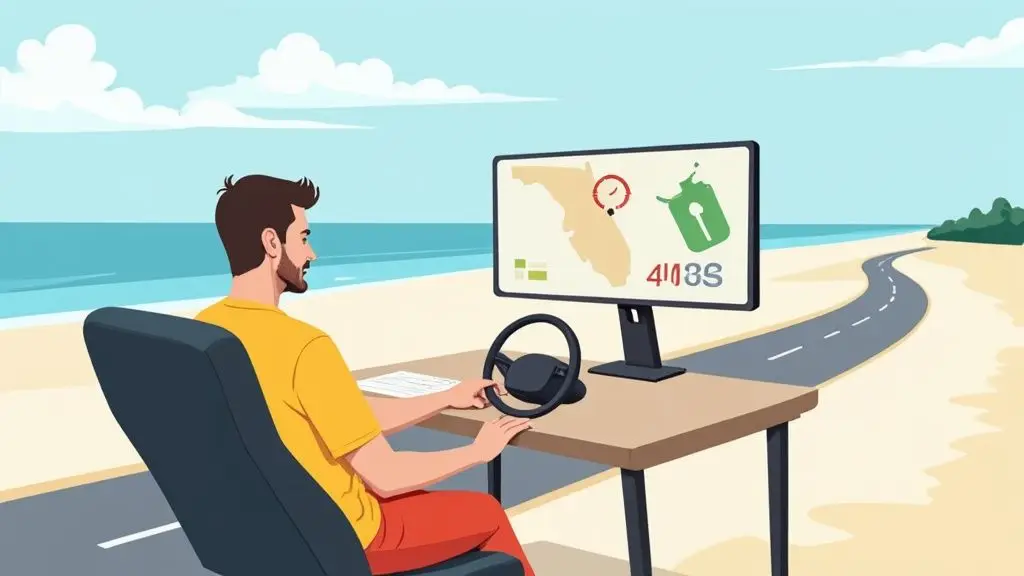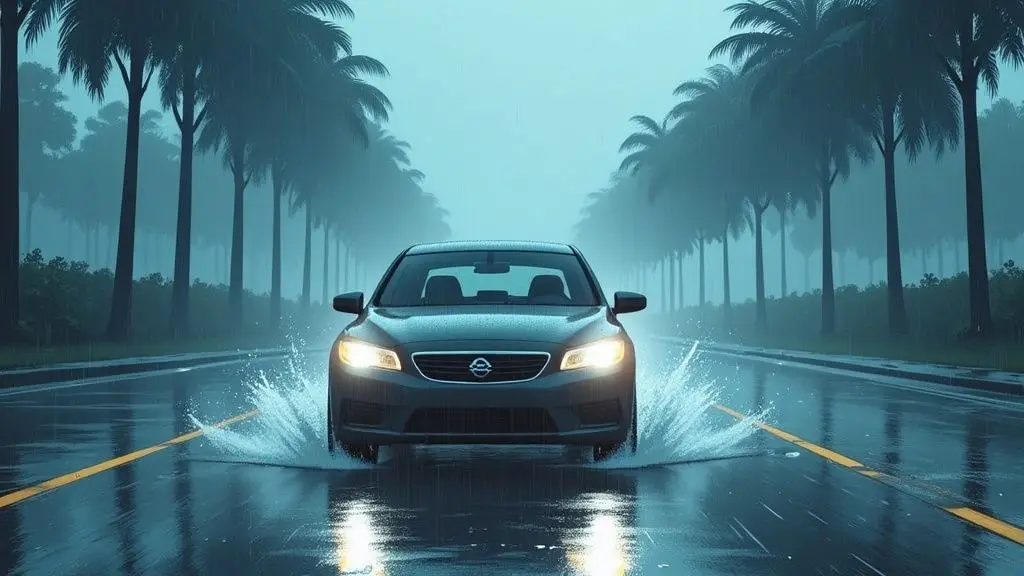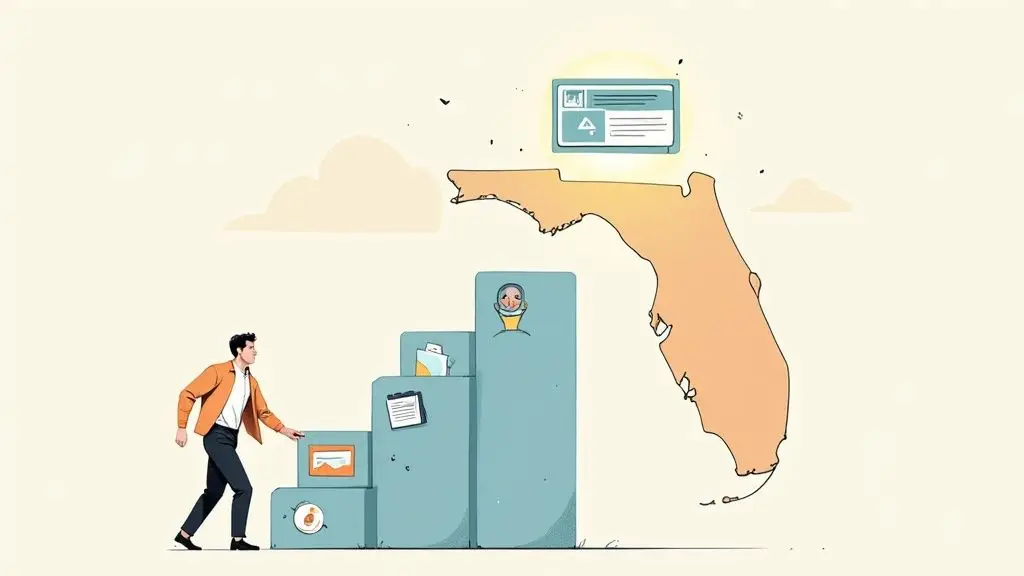Driving in the rain can feel routine, but statistics tell a sobering story. Wet pavement contributes to a staggering number of traffic crashes each year, transforming familiar roads into unpredictable hazards. The transition from dry asphalt to a slick surface dramatically alters your vehicle’s behavior, reducing tire grip, extending stopping distances by a significant margin, and severely limiting visibility for everyone on the road.
Mastering the art of driving in wet conditions is about more than just slowing down; it requires a fundamental shift to a proactive, defensive mindset. This guide provides a comprehensive collection of rain driving safety tips, moving beyond generic advice to offer actionable strategies and practical insights. We will explore everything from the physics of hydroplaning and proper tire maintenance to the most effective ways to use your vehicle’s safety features.
Whether you’re a new driver or simply looking to refresh your knowledge, these detailed tips are designed to empower you. You will learn the specific techniques needed to navigate rainy conditions confidently and safely, helping you protect yourself, your passengers, and others who share the road. Let’s dive into the essential practices that make a critical difference.
1. Reduce Speed and Increase Following Distance
The single most impactful adjustment you can make when driving in the rain is to reduce your speed and significantly increase your following distance. Wet pavement dramatically alters your vehicle’s handling capabilities. Rainwater mixes with oil and dust on the road, creating a slick surface that reduces the friction your tires need to grip the asphalt effectively.
This loss of traction means it takes much longer to slow down or come to a complete stop. In fact, stopping distances on wet roads can easily double compared to dry conditions. Failing to account for this change is a primary cause of rear-end collisions and loss-of-control accidents during inclement weather. Slowing down gives you more time to react to hazards, while a greater following distance provides the crucial buffer needed to brake safely without incident.
The Physics of Wet Roads
When it rains, your vehicle’s tires have to work much harder to maintain contact with the road. The grooves in your tire tread are designed to channel water away, but they can only handle so much at a certain speed. Overwhelm them, and a thin layer of water can lift the tire off the road surface entirely, a dangerous phenomenon known as hydroplaning.
Hydroplaning typically begins at speeds as low as 35 mph, especially if your tires are worn. This is why simply driving the speed limit is often too fast for rainy conditions. Proactively slowing down is a fundamental rain driving safety tip that directly combats the physical limitations imposed by wet roads.
How to Implement This Tip
- Reduce Speed Immediately: As soon as rain begins, decrease your speed by at least 5-10 mph from the posted limit. In a heavy downpour, you may need to reduce your speed by as much as half.
- Master the “Seconds” Rule: In dry weather, a 3-second following distance is standard. In rain, you must double this to at least 6 seconds. To measure this, watch the vehicle ahead of you pass a fixed object (like a sign or tree) and count “one-thousand-one, one-thousand-two…” until your vehicle passes the same object.
- Scan Ahead: Look past the car directly in front of you. Watching the brake lights of vehicles two or three cars ahead can give you an earlier warning of slowing traffic.
- Disable Cruise Control: Cruise control can be dangerous in the rain. It may cause your car to accelerate unexpectedly if you hydroplane, and it prevents you from making the small, constant speed adjustments necessary for safe wet-weather driving.
The bar chart below visualizes the critical impact rain has on your vehicle’s performance and the necessary adjustments you must make.
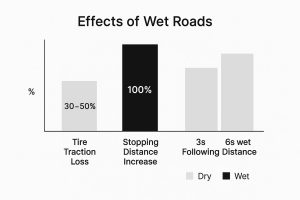
This data clearly illustrates why slowing down is non-negotiable; with traction cut by up to half and stopping distances doubling, a six-second following distance becomes essential for safe reaction time.
2. Turn On Headlights for Visibility
Activating your headlights during rain is not just a courtesy; it’s a critical safety measure and often a legal requirement. Rain, mist, and road spray significantly reduce visibility for everyone on the road. Your headlights serve a dual purpose: they help you see the road ahead more clearly and, just as importantly, they make your vehicle significantly more visible to other drivers, pedestrians, and cyclists.
Relying on daytime running lights is a common and dangerous mistake. While they illuminate the front of your car, they typically do not activate your rear taillights, making you nearly invisible from behind in a downpour. This is why so many states have adopted “wipers on, lights on” laws, a simple but effective rule that has proven to reduce weather-related accidents.

The Science of Visibility
The human eye struggles to distinguish between shades of gray, which dominate the visual landscape during a storm. A gray or silver car can easily blend into the background of a wet, overcast road. The bright, focused beam of a headlight cuts through this monochrome environment, creating a point of contrast that grabs the attention of other drivers much faster.
This principle is backed by data. After Alabama implemented a headlights-with-wipers law, the state saw a 15% reduction in rain-related crashes. Similarly, commercial trucking companies that enforce strict headlight policies report up to 25% fewer weather-related incidents. This simple act is a powerful tool in your arsenal of rain driving safety tips.
How to Implement This Tip
- Follow the “Wipers On, Lights On” Rule: Make it a habit. As soon as you need your windshield wipers, your headlights should be on. This is the law in many states, including Florida.
- Use Low Beams, Not High Beams: High beams are counterproductive in rain and fog. The intense light reflects off the water droplets in the air, creating a wall of glare that severely impairs your vision and blinds oncoming drivers.
- Check Your Lights Regularly: Before the rainy season starts, do a quick walk-around of your vehicle. Ensure both headlights, taillights, and brake lights are functioning correctly.
- Keep Lenses Clean: Dirty or hazy headlight lenses can reduce light output by over 50%. Regular cleaning ensures maximum effectiveness when you need it most.
- Turn Lights On Early: Don’t wait for a heavy downpour. Turn on your lights at the first sign of rain, even during bright daylight, to establish visibility early.
3. Avoid Hydroplaning Through Proper Tire Maintenance and Technique
Hydroplaning is one of the most dangerous situations a driver can face in wet weather. It occurs when a layer of water builds up between your tires and the road surface, causing a complete loss of steering, braking, and power control. This phenomenon can happen at speeds as low as 35 mph, especially with worn tires, effectively turning your car into an uncontrollable sled on water.
Preventing hydroplaning is a crucial rain driving safety tip that hinges on two key factors: proactive tire maintenance and smart driving techniques. Your tires are your only connection to the road, and their ability to channel water away is paramount. When combined with cautious driving habits, proper tire care can significantly reduce your risk of experiencing this terrifying loss of control.
The Physics of Hydroplaning
Your tire treads are not just for grip; they are a system of grooves designed to pump water out from underneath the tire, allowing the rubber to maintain contact with the asphalt. When the volume of water is too great for the treads to handle, or your speed is too high, the tire essentially surfs on top of the water. This is why professional racing series like NASCAR and Formula 1 switch to special rain tires with much deeper treads for wet races.
The same principle applies to public roads. Grooved pavement on highways is designed to help channel water away, but well-maintained tires are still the first and most important line of defense against hydroplaning. Studies from tire manufacturers have shown that tires with only 4/32″ of tread have significantly less wet traction compared to new tires, making them far more susceptible to hydroplaning.
How to Implement This Tip
- Check Tire Tread Depth: Use the penny test. Insert a penny into your tread grooves with Lincoln’s head upside down. If you can see the top of his head, your tread is below the recommended 4/32″ for wet conditions, and it’s time to replace your tires.
- Maintain Correct Tire Pressure: Check your tire pressure at least once a month. Under-inflated tires can close up the tread grooves, reducing their ability to clear water. Always inflate to the manufacturer’s recommended PSI, found on the sticker inside your driver’s side door jamb.
- Avoid Standing Water: Steer clear of puddles and deep water, which tend to collect in the outer lanes of the road. When possible and safe, drive in the tracks left by the vehicles ahead of you, as they will have already displaced some of the water.
- React Calmly If You Hydroplane: If you feel the vehicle begin to hydroplane, do not panic. Take your foot off the accelerator and do not slam on the brakes or jerk the steering wheel. Keep the wheel straight and allow the car to slow down on its own until you feel the tires regain traction.
You can learn more about the importance of routine checks and upkeep by reviewing our guide on Florida vehicle maintenance. Proper care is fundamental to ensuring your vehicle is prepared for inclement weather.
The video below from a professional driving instructor provides a clear visual demonstration of what hydroplaning looks like and how to react correctly.
4. Avoid Sudden Movements and Hard Braking
Smooth, gradual inputs are essential for maintaining control on wet roads where traction is significantly compromised. Sudden steering, hard braking, or rapid acceleration can instantly break the tenuous grip your tires have on the wet pavement. These abrupt actions can easily overwhelm the available friction, causing dangerous skids, spins, or a complete loss of vehicle control.
The principle is simple: treat the accelerator, brake, and steering wheel with gentle, progressive movements. This approach, often summarized by professional drivers as “smooth is fast,” is even more critical for everyday safety in the rain. Every input should be deliberate and measured to keep the vehicle balanced and stable, ensuring the tires remain in contact with the road and within their traction limits. This is a foundational skill taught in advanced driver training and is one of the most vital rain driving safety tips.
The Physics of Vehicle Dynamics
When you accelerate, brake, or steer, you shift the vehicle’s weight. A hard brake throws weight forward, a sharp turn shifts it sideways, and aggressive acceleration moves it backward. On a dry road, your tires can usually handle these shifts. On a wet surface, that same weight transfer can overload the tires, causing them to lose their grip.
Smooth inputs manage this weight transfer gradually, preventing any single tire from being suddenly overwhelmed. By braking, steering, and accelerating with finesse, you allow the vehicle’s suspension and tires to adapt without breaking traction. This ensures you remain in control, even when the road surface offers minimal grip.
How to Implement This Tip
- Brake Sooner and Gentler: Begin slowing down much earlier for stops and turns than you would in dry conditions. Apply light, steady pressure to the brake pedal instead of jabbing at it.
- Accelerate with Care: Apply gentle pressure to the accelerator to avoid wheel spin, especially from a complete stop or while turning.
- Steer Smoothly: Make all steering adjustments gradually. Avoid jerking the wheel for lane changes or turns; instead, guide the car with fluid hand movements.
- Anticipate and Plan: Look far ahead down the road to anticipate changes in traffic or road conditions. This gives you more time to react smoothly instead of being forced into an emergency maneuver. A key part of this is knowing how to respond if your brakes don’t work as expected.
- Use Engine Braking (Manual Vehicles): In a manual transmission vehicle, downshift smoothly and gradually to let the engine help slow the car, reducing reliance on the brakes.
5. Use Windshield Wipers and Defrosters Effectively
Maintaining a clear line of sight through your windshield is a non-negotiable aspect of driving safely in the rain. Your ability to spot hazards, read signs, and react to changing traffic conditions is entirely dependent on visibility. When rain falls, this visibility is immediately challenged by water on the outside and fog on the inside, making effective use of your wipers and defrosters a critical safety skill.
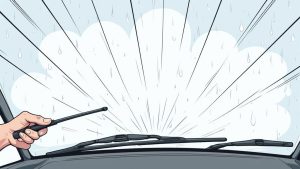
Many drivers underestimate the danger of compromised visibility. According to AAA, a shocking 90% of vehicles may have worn wiper blades that streak, smear, or fail to clear the windshield properly. This seemingly minor maintenance issue directly impacts your perception and reaction time, turning a manageable drive into a hazardous one.
The Science of Clear Vision
Your vehicle’s climate control system is an essential safety tool in wet weather. Interior fog forms when the warm, humid air inside your car meets the cold surface of the windshield, causing condensation. The defroster combats this by blowing dry air onto the glass. Engaging your air conditioning (A/C) button simultaneously is the most effective method, as the A/C system acts as a dehumidifier, rapidly removing moisture from the air and clearing the fog much faster than heat alone.
Simultaneously, high-quality wiper blades are engineered to squeegee water off the exterior glass, creating a consistent, clear view. When blades are worn, cracked, or hardened, they leave behind streaks and sheets of water that refract light from headlights and streetlights, creating dangerous glare and obscuring your vision. This is why many professional drivers, like truckers, replace their wipers on a strict semi-annual schedule.
How to Implement This Tip
- Proactive Wiper Replacement: Replace your wiper blades every 6 to 12 months or as soon as you notice streaking, chattering, or skipping. Don’t wait for them to fail during a downpour.
- Master the Defroster/AC Combo: When your windows start to fog, immediately turn on your front defroster and activate the A/C. Direct the air vents toward the side windows to clear them as well.
- Keep It Clean, Inside and Out: A dirty windshield, both inside and out, worsens visibility issues. Clean the exterior glass and wiper blades regularly with glass cleaner. Also, clean the inside of the windshield to remove the thin film that attracts condensation.
- Match Wiper Speed to Rainfall: Adjust your wiper speed to match the intensity of the rain. A speed that is too slow will leave your view obscured, while one that is too fast can cause premature wear and annoying “chatter” on a lightly wet windshield.
- Use Washer Fluid: Apply windshield washer fluid to help clear away road grime and oils that can cause smearing when mixed with rain. Ensure your reservoir is full with a quality, all-season fluid.
6. Be Cautious of Road Hazards and Standing Water
Rainfall transforms a familiar road into an unpredictable landscape filled with hidden dangers. Standing water can conceal deep potholes or road damage, while painted lines, metal utility covers, and railroad tracks become incredibly slick. Being aware of these amplified hazards is a critical component of rain driving safety tips that goes beyond just managing your own vehicle’s speed.
The initial moments of a downpour are often the most treacherous. When rain first begins, it mixes with the accumulated oil, grease, and rubber dust on the asphalt, creating an exceptionally slippery film. This “first rain” phenomenon causes a sharp increase in accidents before the contaminants are washed away. Failing to recognize and respect these temporary but severe conditions can easily lead to a loss of control.
The Physics of Hidden Dangers
Water dramatically changes the coefficient of friction on various surfaces. While asphalt loses a significant amount of grip, non-porous surfaces like painted road markings and metal plates lose almost all of it. A maneuver that is safe on dry pavement, like braking over a crosswalk or accelerating over a bridge joint, can trigger a skid in the rain.
Furthermore, water’s ability to obscure depth is a major risk. A puddle that appears shallow could be deep enough to damage your vehicle’s undercarriage, flood its engine, or even cause you to lose control. According to NOAA, it takes just 12 inches of moving water to float most passenger cars, highlighting the immense danger of underestimating standing water.
How to Implement This Tip
- Avoid Standing Water: Never drive through pooled water if you cannot see the road surface beneath it. If you encounter a flooded area, remember the simple rule: “Turn around, don’t drown.” It is always safer to find an alternate route.
- Treat Painted Surfaces with Care: Reduce your speed and avoid hard braking or sharp turns on painted crosswalks, lane dividers, and directional arrows. These surfaces offer very little traction when wet.
- Be Wary of Metal: Approach metal surfaces like bridge expansion joints, railroad tracks, and manhole covers with extreme caution. Slow down before reaching them and cross as smoothly as possible.
- Heed the “First 10 Minutes” Rule: Be extra vigilant during the initial moments of rainfall when roads are at their slickest. Proactively reducing speed during this period is crucial.
- Dry Your Brakes: After driving through an unavoidable puddle, gently tap your brakes a few times. This helps squeeze water from the rotors and pads, restoring their normal stopping effectiveness. You can learn more about these specific rain driving safety measures on bdischool.com.
- Scan for “Roostertails”: Watch the spray coming from the tires of cars ahead. A large “roostertail” indicates deep standing water, giving you an early warning to slow down or change lanes if possible.
7. Plan Routes and Check Weather Conditions Before Driving
One of the most effective rain driving safety tips is applied before you even turn the key. Proactive trip planning allows you to avoid the most hazardous situations altogether by making informed decisions based on weather forecasts, road conditions, and route characteristics. Instead of reacting to danger on the road, you can strategically sidestep it.
This preparation involves more than a quick glance at the daily forecast. Modern technology provides real-time, detailed data, from precipitation intensity on weather radar to live traffic updates and road closure alerts. Using these tools to adjust your route or even your departure time is a fundamental risk-management strategy that can prevent you from driving into a flash flood or getting stuck in weather-related gridlock.
The Power of Proactive Planning
Commercial and emergency services have long understood the value of meteorological intelligence. Logistics companies like UPS and FedEx use sophisticated routing software to navigate around severe weather, ensuring safety and efficiency. Similarly, emergency services monitor weather patterns to pre-position resources in high-risk areas. Applying this same principle to your personal travel elevates your safety from a matter of chance to a deliberate choice.
Anticipating potential problems, such as knowing a specific underpass on your route is prone to flooding, allows you to program an alternate path into your GPS before you leave. This simple act of planning prevents you from making a risky, last-minute decision in a high-stress environment, directly reducing your odds of an accident.
How to Implement This Tip
- Check Hourly Forecasts and Radar: Before departing, review the hourly weather forecast and use a weather radar app. This shows you not just if it will rain, but the intensity and movement of storm cells, helping you time your trip to avoid the worst downpours.
- Identify Flood-Prone Areas: Mentally or digitally map out your route and identify low-lying roads, underpasses, and areas near creeks or rivers that are known to flood. Have a safer, higher-elevation alternative in mind.
- Use Real-Time Road Reports: Check your state’s Department of Transportation website or call its 511 information line for the latest updates on road closures, accidents, or standing water.
- Build in a Time Buffer: Rushing is a recipe for disaster in poor weather. Always add extra time to your travel schedule to account for slower speeds and potential delays. This removes the pressure to take unnecessary risks.
- Delay Non-Essential Travel: If a severe weather warning is issued, the safest decision is often not to drive at all. Postponing non-critical errands or appointments is a key part of this rain driving safety tip.
8. If Conditions Become Severe, Pull Over Safely
There are moments when the best rain driving safety tip is to stop driving altogether. When a torrential downpour or severe thunderstorm reduces visibility to a few feet, or when high winds make controlling your vehicle difficult, continuing to drive puts you and others at extreme risk. The safest decision is to find a secure location and wait for the worst of the weather to pass.
Many drivers make the critical mistake of stopping in a travel lane or on the shoulder of a highway, which can create an even more dangerous situation. Recognizing when conditions have surpassed your vehicle’s and your own capabilities is a crucial skill. Prioritizing safety over reaching your destination on time is the ultimate defensive driving maneuver in severe weather.
The Dangers of Low Visibility
Intense rainfall, often associated with thunderstorm outflow, can create a “white-out” effect where visibility drops to near zero almost instantly. In these conditions, you cannot see other vehicles, road hazards, or even the lane markings. Professional truck drivers are trained to pull over in these situations because they understand that moving forward blindly is a recipe for disaster.
States prone to extreme weather, like Florida, often run public service campaigns encouraging drivers to pull over during these events. Learn more about the specific strategies for driving safety during severe weather in Florida to be better prepared. Choosing to stop is not a sign of weakness; it is a calculated, life-saving decision.
How to Implement This Tip
- Prioritize Safe Locations: Your goal is to get completely off the roadway. Look for a parking lot, rest area, or gas station. Never park under an overpass, as this blocks the shoulder for emergency vehicles and creates a dangerous bottleneck.
- Use the Shoulder as a Last Resort: If you must stop on the shoulder, pull as far to the right as possible. Turn on your emergency hazard lights but turn off your headlights. This prevents other drivers from mistaking your stationary vehicle for one that is in motion and following your lights into a collision.
- Stay in Your Vehicle: Remain in your car with your seatbelt fastened. Your vehicle offers protection from traffic and lightning, which acts like a Faraday cage, directing the electrical charge around the exterior.
- Wait It Out: Heavy downpours often last only 15-20 minutes. Use your phone to check the weather radar to see how long the intense cell is expected to last. Notify your destination that you are safely stopped and will be delayed.
Rain Driving Safety Tips Comparison Table
| Safety Measure | Implementation Complexity 🔄 | Resource Requirements ⚡ | Expected Outcomes 📊 | Ideal Use Cases 💡 | Key Advantages ⭐ |
|---|---|---|---|---|---|
| Reduce Speed and Increase Following Distance | Moderate: Requires constant speed adjustment and vigilance | Low: No equipment needed, driver effort only | High: 40-70% reduction in rain-related crashes | All rain conditions, especially heavy rain, poor visibility | Significantly lowers collision and hydroplaning risk; improves control |
| Turn On Headlights for Visibility | Low: Simple action, often automatic in modern cars | Very Low: Built-in vehicle feature | Moderate: Up to 300% increase in vehicle visibility | During rain, low visibility, legal requirement | Enhances visibility to others; reduces rear-end collisions |
| Avoid Hydroplaning Through Proper Tire Maintenance and Technique | High: Requires maintenance and awareness | Medium: Costs for tire upkeep/replacement | High: Prevents loss of steering control and skids | Speeds above 35 mph, wet roads with standing water | Prevents dangerous traction loss; safer handling with maintained tires |
| Avoid Sudden Movements and Hard Braking | Moderate: Needs increased concentration and smooth driving | None: Driver technique | High: Preserves stability and reduces skid risk | All wet conditions, especially slippery roads | Maintains vehicle control; reduces wear on vehicle components |
| Use Windshield Wipers and Defrosters Effectively | Low: Routine maintenance and proper use | Low: Cost of wiper blades and washer fluid | High: Immediate improvement in visibility | All rain conditions | Ensures clear vision; inexpensive and easy safety measure |
| Be Cautious of Road Hazards and Standing Water | Moderate: Requires vigilance and hazard awareness | None | Moderate: Helps avoid hidden dangers and hydroplaning | Heavy rain, flash flooding, first rain after dry spells | Enables proactive hazard avoidance; reduces unexpected accidents |
| Plan Routes and Check Weather Conditions Before Driving | Low: Requires pre-trip time and app use | Low: Access to weather and traffic apps | Moderate: Avoids severe conditions and delays | Before travel in rainy forecasts | Allows safer route choice; reduces exposure to hazards |
| If Conditions Become Severe, Pull Over Safely | Low to Moderate: Must identify safe spots and judgment | None | High: Eliminates risk during extreme conditions | Severe rain, near-zero visibility, thunderstorms | Prevents accidents in dangerous conditions; allows rest and hazard assessment |
Turn Your Knowledge into Safer Driving Habits
Navigating rain-slicked roads isn’t just about knowing what to do; it’s about making those actions an instinctual part of your driving routine. The journey through these essential rain driving safety tips has equipped you with a comprehensive toolkit designed to mitigate risk and enhance your control behind the wheel. We’ve moved beyond the obvious, delving into the specifics of vehicle preparedness, driver behavior, and environmental awareness.
The core principle that ties all these strategies together is proactive defense. True road safety isn’t reactive; it’s about anticipating challenges before they arise. It’s checking your tire tread before the storm season begins, not after you’ve already felt your car hydroplane. It’s increasing your following distance at the first sign of drizzle, not after the car ahead of you brakes suddenly. This mindset transforms you from a passive operator into an engaged, tactical driver.
From Theory to Practice: Your Action Plan
The real value of this knowledge comes from consistent application. Don’t wait for a torrential downpour to start practicing these habits. Turn them into your default driving mode every time the weather turns.
- Vehicle Readiness: Make checking your wipers, tires, and defroster a part of your regular vehicle maintenance schedule. A 10-minute check once a month can prevent a serious incident on the road.
- Mental Preparation: Before you even start the engine on a rainy day, consciously remind yourself to slow down, increase your following distance, and stay hyper-aware of your surroundings. This simple mental reset primes your brain for defensive driving.
- Habit Formation: The next time it rains, actively practice smooth, deliberate movements. Gently ease onto the brakes, make wider turns, and consciously scan for standing water and slick spots, especially those telltale rainbows indicating oil on the pavement.
The Lasting Impact of Safe Driving
Mastering these skills does more than just get you safely from point A to point B during a storm. It cultivates a deeper sense of confidence and control, reducing the stress and anxiety that often accompany driving in poor weather. For drivers in Florida, these habits are particularly crucial, where sudden downpours are a common part of daily life. By consistently applying these rain driving safety tips, you not only protect yourself and your passengers but also contribute to a safer driving environment for everyone on the road. Your deliberate, informed actions create a ripple effect of safety.
Remember, the safest tool you have in any vehicle isn’t the airbags or the anti-lock brakes; it’s a well-informed, prepared, and attentive driver. The goal is to make these safe driving practices so ingrained that they become second nature. Stay prepared, stay vigilant, and drive with the confidence that comes from genuine skill and knowledge.
Ready to formalize your defensive driving knowledge and potentially lower your insurance premiums or address a recent traffic violation? Enroll in a state-approved Basic Driver Improvement course with BDISchool to reinforce these critical safety skills. Our convenient online platform makes it easy to become a safer, more confident driver on Florida’s roads, rain or shine. Learn more and sign up today at BDISchool.
